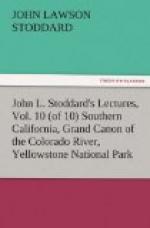[Illustration: Not afraid of the sun.]
One day, in June, I was invited to dine at a fruit-ranch a few miles from Pasadena. The heat in the sun was intense, and I noticed that the mercury indicated ninety-five degrees; but, unlike the atmosphere of New York in a heated term, the air did not remind me of a Turkish bath. The heat of Southern California is dry, and it is absolutely true that the highest temperature of an arid region rarely entails as much physical discomfort as a temperature fifteen or twenty degrees lower in the Eastern States, when accompanied by humidity. The moisture in a torrid atmosphere is what occasions most of the distress and danger, the best proof of which is the fact that while, every summer, hundreds of people are prostrated by sunstroke near the Atlantic coast, such a calamity has never occurred in New Mexico, Arizona, or California. Moreover, when the mercury in Los Angeles rises, as it occasionally does, to one hundred degrees, the inhabitants of that city have a choice of several places of refuge: in two or three hours they can reach the mountains; or in an hour they can enjoy themselves upon Redondo Beach; or they may take a trolley car and, sixty minutes later, stroll along the sands of Santa Monica, inhaling a refreshing breeze, blowing practically straight from Japan; or, if none of these resorts is sufficiently attractive, three hours after leaving Los Angeles they can fish on Santa Catalina Island, a little off the coast; or linger in the groves of Santa Barbara; or, perhaps, best of all can be invigorated by the saline breath of the Pacific sweeping through the corridors of the Coronado. Santa Catalina Island is, in particular, a delightful pleasure-resort, whose beautiful, transparent waters, remarkable fishing-grounds, and soft, though tonic-giving air, which comes to it from every point of the compass over a semi-tropic sea, are so alluring that thousands of contented people often overflow its hotels and camp in tents along the beach.
[Illustration: In Cottonwood canon, Santa Catalina.]
[Illustration: Liliputian and giant.]
[Illustration: On the beach at Santa Catalina.]
That the winter climate of Southern California, not only on the coast, but in the interior, is delightful, is beyond question. What was healthful a hundred years ago to the Spanish monks who settled here, proved equally so to those adventurous “Forty-niners” who entered California seeking gold, and is still more beneficial to those who now come to enjoy its luxuries and comforts. Flowers and fruit are found here throughout the entire year. The rainy days are few, and frosts are as ephemeral as the dew; and to the aged, the invalids, the fugitives from frost, and the “fallen soldiers of civilization,” who are no longer able to make a courageous fight




